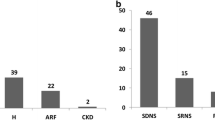Abstract
Background
Current guidelines note a gap in high-quality evidence regarding utility of kidney ultrasonography (KUS) during initial evaluation of nephrotic syndrome (NS) due to presumed minimal change disease (pMCD). However, KUS is frequently obtained at our institution. This retrospective chart review assessed incidence and impact of abnormal sonographic findings in these patients.
Methods
Patients 1–18 years, newly diagnosed at our institution with NS from pMCD between 2011 and 2021, were identified. Hypertension, urinalysis, kidney function, and steroid responsiveness data were collected. Imaging findings were abstracted from radiology reports. Clinical impact of KUS was defined by actions taken in response to KUS.
Results
A total of 173 patients identified with new NS; 98 met inclusion criteria. Of these, 54% had KUS during the initial encounter. Demographic and laboratory data did not differ between those with and without KUS. KUS were abnormal in 70% of studies: increased kidney echogenicity (39.6%) and nephromegaly (35.8%) were the most common abnormal findings. Other findings included decreased corticomedullary differentiation, lobular kidney contour, solitary simple kidney cyst, and mild unilateral hydronephrosis. Steroid resistance was not associated with either nephromegaly or abnormal echogenicity.
Conclusions
Our data showed no clinically relevant ultrasound findings causing deviations from the standard of care for pMCD. There was no association between KUS findings and steroid resistance. These data suggest there is little to no benefit from routine KUS imaging in patients with pMCD upon initial presentation.
Graphical abstract

A higher resolution version of the Graphical abstract is available as Supplementary information
Similar content being viewed by others
Data availability
The datasets generated during and/or analyzed during this current study are available from the corresponding author upon request.
References
Dillman JR, Smith EA, Coley BD (2017) Ultrasound imaging of renin-mediated hypertension. Pediatr Radiol 47:1116–1124. https://doi.org/10.1007/s00247-017-3840-y
Subcommittee on urinary tract infection, steering committee on quality improvement and management; Roberts KB (2011) Urinary tract infection: clinical practice guideline for the diagnosis and management of the initial UTI in febrile infants and children 2 to 24 months. Pediatrics 128:595–610. https://doi.org/10.1542/peds.2011-1330
Gershen RS, Brody AS, Duffy LC, Springate JE (1994) Prognostic value of sonography in childhood nephrotic syndrome. Pediatr Nephrol 8:76–78. https://doi.org/10.1007/BF00868271
Trautmann A, Boyer O et al (2023) IPNA clinical practice recommendations for the diagnosis and management of children with steroid-sensitive nephrotic syndrome. Pediatr Nephrol 38(3):877–919. https://doi.org/10.1007/s00467-022-05739-3
Flynn JT, Kaelber DC, Baker-Smith CM et al (2017) Clinical practice guideline for screening and management of high blood pressure in children and adolescents. Pediatrics 140:e20171904. https://doi.org/10.1542/peds.2017-1904
Schwartz GJ, Muñoz A, Schneider MF et al (2009) New equations to estimate GFR in children with CKD. J Am Soc Nephrol 20:629–637. https://doi.org/10.1681/ASN.2008030287
Obrycki Ł, Sarnecki J, Lichosik M et al (2022) Kidney length normative values in children aged 0–19 years—a multicenter study. Pediatr Nephrol 37:1075–1085. https://doi.org/10.1007/s00467-021-05303-5
Huang H-P, Lai Y-C, Tsai I-J et al (2008) Nephromegaly in children with Kawasaki disease: new supporting evidence for diagnosis and its possible mechanism. Pediatr Res 63:207–210. https://doi.org/10.1203/PDR.0b013e31815ef737
Kidney disease: improving global outcomes (KDIGO) glomerular diseases work group (2021) KDIGO 2021 clinical practice guideline for the management of glomerular diseases. Kidney Int 100:S1–S276. https://doi.org/10.1016/j.kint.2021.05.021
Agrwal S, Mantan M, Dabas A, Batra VV (2022) Childhood steroid-resistant nephrotic syndrome: long-term outcomes from a tertiary care center. Indian J Nephrol 32:320–326. https://doi.org/10.4103/ijn.ijn_258_21
Patel PJ, al-Rasheed SA, al-Mugeiren MM, Malabarey T (1991) Sonographic findings in infantile idiopathic nephrotic syndrome. Child Nephrol Urol 11:209–211
Salame H, Damry N, Vandenhoudt K et al (2003) The contribution of ultrasound for the differential diagnosis of congenital and infantile nephrotic syndrome. Eur Radiol 13:2674–2679. https://doi.org/10.1007/s00330-003-1920-x
Atalabi OM, Afolabi OS, Asinobi AO (2015) Renal doppler indices in children with nephrotic syndrome: findings from a tertiary hospital in Nigeria. Niger J Physiol Sci 30:17–23
Kasap B, Soylu A, Türkmen M, Kavukcu S (2006) Relationship of increased renal cortical echogenicity with clinical and laboratory findings in pediatric renal disease. J Clin Ultrasound 34:339–342. https://doi.org/10.1002/jcu.20243
O’Neill WC (2014) Renal relevant radiology: use of ultrasound in kidney disease and nephrology procedures. Clin J Am Soc Nephrol 9:373–381. https://doi.org/10.2215/CJN.03170313
Author information
Authors and Affiliations
Contributions
All authors contributed to the study conception and design. Data collection and analysis were performed by JSC. The first draft of the manuscript was written by JSC, and all authors edited and revised the manuscript. All authors read and approved the final manuscript.
Corresponding author
Ethics declarations
Ethics approval
This research study was conducted retrospectively from data obtained for clinical purposes with approval from the IRB of Baylor College of Medicine.
Competing interests
The authors declare no competing interests.
Additional information
Publisher's Note
Springer Nature remains neutral with regard to jurisdictional claims in published maps and institutional affiliations.
Supplementary Information
Below is the link to the electronic supplementary material.
Rights and permissions
Springer Nature or its licensor (e.g. a society or other partner) holds exclusive rights to this article under a publishing agreement with the author(s) or other rightsholder(s); author self-archiving of the accepted manuscript version of this article is solely governed by the terms of such publishing agreement and applicable law.
About this article
Cite this article
Chawla, J.S., Angelo, J.R. & Braun, M.C. Utility of kidney ultrasonography during initial evaluation of pediatric nephrotic syndrome. Pediatr Nephrol 39, 613–617 (2024). https://doi.org/10.1007/s00467-023-06166-8
Received:
Revised:
Accepted:
Published:
Issue Date:
DOI: https://doi.org/10.1007/s00467-023-06166-8




